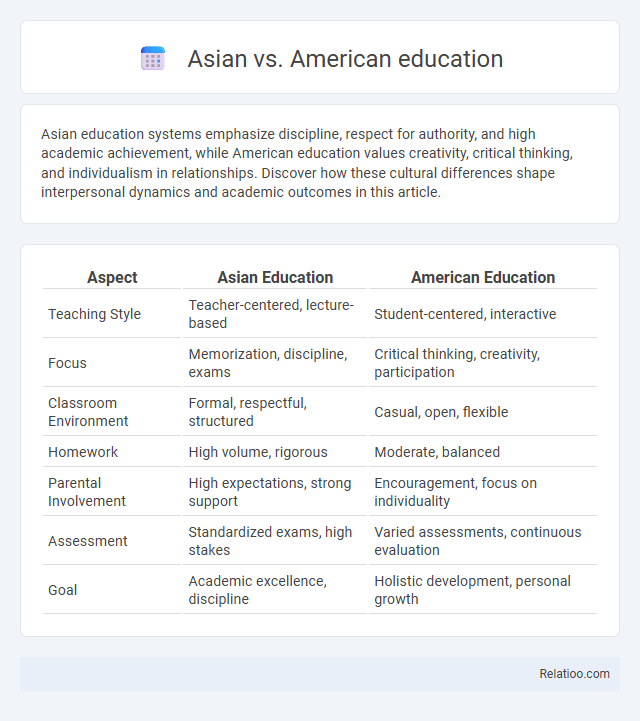Asian education systems emphasize discipline, respect for authority, and high academic achievement, while American education values creativity, critical thinking, and individualism in relationships. Discover how these cultural differences shape interpersonal dynamics and academic outcomes in this article.
Table of Comparison
| Aspect | Asian Education | American Education |
|---|---|---|
| Teaching Style | Teacher-centered, lecture-based | Student-centered, interactive |
| Focus | Memorization, discipline, exams | Critical thinking, creativity, participation |
| Classroom Environment | Formal, respectful, structured | Casual, open, flexible |
| Homework | High volume, rigorous | Moderate, balanced |
| Parental Involvement | High expectations, strong support | Encouragement, focus on individuality |
| Assessment | Standardized exams, high stakes | Varied assessments, continuous evaluation |
| Goal | Academic excellence, discipline | Holistic development, personal growth |
Overview of Asian and American Education Systems
Asian education systems emphasize rigorous curriculum, high-stakes exams, and a strong focus on STEM subjects, leading to disciplined study habits and competitive academic environments. American education prioritizes critical thinking, creativity, and extracurricular involvement, fostering well-rounded personal development and flexible learning paths. Understanding these distinct approaches helps you align your education expectations with your academic goals and cultural values.
Curriculum Structure: East vs West
Asian education systems emphasize rigorous, standardized curriculum structures with a strong focus on core subjects like mathematics, science, and language mastery, promoting discipline and high academic achievement. American education prioritizes a flexible curriculum that encourages creativity, critical thinking, and interdisciplinary learning, offering diverse electives and extracurricular activities to support holistic development. These differing curriculum expectations reflect cultural values, with Asian systems favoring structured knowledge acquisition and Western systems fostering innovation and individual expression.
Teaching Methods and Classroom Culture
Asian education emphasizes rote memorization and teacher-centered instruction, fostering discipline and respect for authority, while American education prioritizes student-centered learning and critical thinking, encouraging interaction and creativity. Classroom culture in Asia often involves high academic pressure and structured schedules, contrasting with the more flexible, discussion-driven environments common in American schools. Expectations in Asian systems focus on exam performance and mastery of content, whereas American education values holistic development and practical application of knowledge.
Role of Examinations and Assessments
Examinations and assessments play a pivotal role in both Asian and American education systems, shaping students' academic progress and future opportunities. In many Asian countries, high-stakes exams like the Gaokao or JEE determine access to top universities, creating immense pressure on students to excel and prioritize rote learning. Your education expectations may vary, as American education often emphasizes continuous assessment, creativity, and critical thinking, offering multiple pathways for student success beyond standardized testing.
Student-Teacher Relationships
Asian education systems emphasize rigorous respect and hierarchy in student-teacher relationships, fostering discipline and high academic expectations. American education prioritizes a more collaborative and informal dynamic, encouraging open dialogue and critical thinking between students and teachers. Understanding these cultural differences can help you navigate and meet education expectations effectively in diverse learning environments.
Parental Involvement and Expectations
Asian education systems often emphasize rigorous academic achievement with high parental involvement, where parents expect their children to excel in core subjects like math and science through disciplined study habits. American education prioritizes a balanced approach, encouraging creativity and extracurricular activities, with parental expectations focusing on both academic performance and personal development. Your role as a parent or student can influence these educational outcomes by aligning support and expectations with the cultural values and learning styles prevalent in each system.
Focus on STEM vs Liberal Arts
Asian education systems emphasize rigorous STEM curricula, prioritizing math, science, and engineering to drive technological innovation and economic growth. American education often balances STEM with liberal arts, fostering critical thinking, creativity, and communication skills to prepare students for diverse career paths. Your educational expectations may align with Asia's focus on technical mastery or America's encouragement of interdisciplinary learning, depending on your long-term goals.
Extracurricular Activities and Holistic Development
Asian education systems often emphasize rigorous academic achievement with limited integration of extracurricular activities, reflecting cultural expectations prioritizing test scores and knowledge acquisition. American education promotes holistic development through a balanced curriculum that includes sports, arts, and leadership opportunities, fostering social skills and creativity alongside academics. Education expectations in Asia are increasingly shifting towards incorporating extracurricular engagement to develop well-rounded individuals capable of critical thinking and collaboration.
Attitudes Toward Academic Achievement and Failure
Asian education systems often emphasize high academic achievement and view failure as a critical learning opportunity, fostering resilience and persistence among students. In contrast, American education tends to promote creativity and individualism, sometimes valuing personal growth over standardized performance metrics. Expectations in both cultures shape attitudes and approaches to success and failure, influencing student motivation and long-term academic outcomes.
Global Impact and Future Trends
Asian education systems emphasize rigorous academics, discipline, and STEM skills, fueling rapid economic growth and technological innovation that shape global markets. American education prioritizes creativity, critical thinking, and diverse learning approaches, preparing Your workforce for adaptability in an evolving global economy. Future trends highlight a blend of these models, integrating digital learning and cross-cultural competencies to meet global demands and enhance international collaboration.

Infographic: Asian vs American education
 relatioo.com
relatioo.com